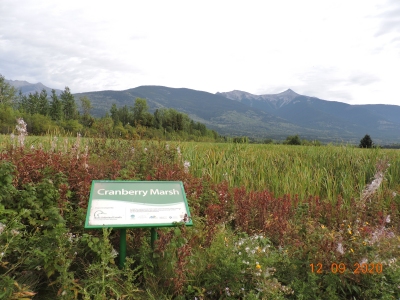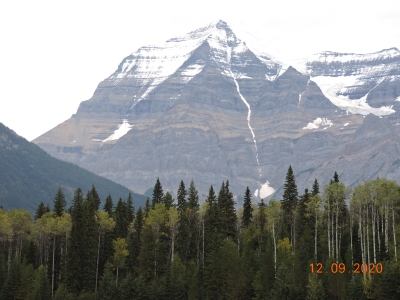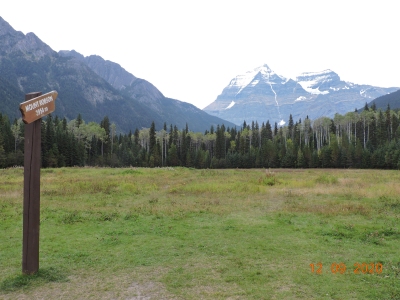North in the Spring #15:
Kamloops to Alaska Highway the Eastern Route Part Two; Cranberry Marsh to Mount Robson by John Neville
Continuing on Hwy 5, on the right before Valemont, is the Cranberry Marsh. This is well worth a visit. The trailhead is next to the Best Western Hotel. Recently the trails have been improved, and make easy walking along the dykes, and through the woods. There are moose, coyote, both kinds of deer, muskrat, beaver, dabbling and diving ducks, raptors, owls and more. The White-tailed deer hold their tail upright when alarmed, and the underside shows white as it seems to wave goodbye. The Mule deer has larger ears and a larger white rump with some black on the tip of the tail. Coyotes weigh about 10 kg, and stand 50 cm tall( about the size of a Border Collie). The bushy tail is about 30 cm long. In the marsh coyote eat young water foul, berries, grasses, muskrat, frogs and carrion.
 In the middle of Valemont is Swift Creek spawning channel. If you happen to be in the area in August or September, you can see the Chinook Salmon spawning. They are the largest pacific salmon and swim 1340 km up the Fraser River to reach Valemont. They are also known as: Tyee, King and Spring Salmon.
In the middle of Valemont is Swift Creek spawning channel. If you happen to be in the area in August or September, you can see the Chinook Salmon spawning. They are the largest pacific salmon and swim 1340 km up the Fraser River to reach Valemont. They are also known as: Tyee, King and Spring Salmon.The next stop on the left was Jackman Flats Provincial Park. Initially, sand was deposited in a post glacial lake and after it dried up, winds blew the sand to form todays dunes. Amongst the unusual plants are Pine Dwarf Mistletoe growing on the Lodgepole Pine and wide-spread Lichens on the ground. The short yellowish stems of the mistletoe penetrate the pine bark, sending its roots into the nutrient rich cambium layer of the tree. The puffy gray-green growths, on the ground at Jackman Flats look like moss, but they are Lichens. This is a special kind of fungus, which combines with algae, or Cyanobacteria, to form the Lichens. We followed a good trail through the sand dune landscape, where you might see Snowshoe hare and Red-breasted Nuthatch amongst others. The Nuthatch can often be spotted or heard, as it descends head-first, down tree trunks looking for insects.  We walked the trail just after a storm had swept through this part of the Rocky Mountain Trench. The air was clean and scented causing me to draw in deep drafts of the pleasant earthy odour. Raindrops damage the minute hairs on leaves releasing volatile plant oils. Raindrops hitting the ground stimulate bacteria to release geosmin from the soil. The electrical charge created by the storm added ozone to my olfactory senses. In the 1960's two Australian researchers named this earthy odour "Petrichor" from two greek words.
We walked the trail just after a storm had swept through this part of the Rocky Mountain Trench. The air was clean and scented causing me to draw in deep drafts of the pleasant earthy odour. Raindrops damage the minute hairs on leaves releasing volatile plant oils. Raindrops hitting the ground stimulate bacteria to release geosmin from the soil. The electrical charge created by the storm added ozone to my olfactory senses. In the 1960's two Australian researchers named this earthy odour "Petrichor" from two greek words.The next turning on the left is to Tete Jaune Cache. Pierre Bostonais was a blond, or yellowheaded Iroquois French trapper and guide. His yellow head gives us the Yellowhead Highway, or Highway 16, which reaches from Prince Rupert across four provinces to a little east of Brandon, Manatoba, where it joins Highway 1. We turned east on Highway 16, and followed the Fraser River upstream. At Rearguard Falls you can watch the Chinook leaping the falls in August. A few km further along are Overlander Falls, named after the gold-seakers who passed this way in 1862. The falls are too high for salmon but you might witness a few leaping unsuccessfully in August.  We soon were at Mount Robson, our second oldest provincial park, 1913, and the highest mountain in the Canadian Rockies at 3.954m. The road followed the upper valley of the mighty Fraser River, which is 1.440km, long. After passing the Mount Robson look out, the road gradually ascends an old glacial steppe. The next feature is Moose Lake, about 11km long and 87m. deep. This is the only lake formed by the Fraser. On the right hand valley wall look and listen for Thunder Falls, which drains a hanging glacial trough. On a summer day, when the glacier is melting, it really thunders! The road crosses the Fraser twice in its upper reaches which gives good views of the river. The headwaters are in the Fraser Pass to the southeast. I recall once stepping over a tiny creek in the Tonquin Valley which flows down into those headwaters.
We soon were at Mount Robson, our second oldest provincial park, 1913, and the highest mountain in the Canadian Rockies at 3.954m. The road followed the upper valley of the mighty Fraser River, which is 1.440km, long. After passing the Mount Robson look out, the road gradually ascends an old glacial steppe. The next feature is Moose Lake, about 11km long and 87m. deep. This is the only lake formed by the Fraser. On the right hand valley wall look and listen for Thunder Falls, which drains a hanging glacial trough. On a summer day, when the glacier is melting, it really thunders! The road crosses the Fraser twice in its upper reaches which gives good views of the river. The headwaters are in the Fraser Pass to the southeast. I recall once stepping over a tiny creek in the Tonquin Valley which flows down into those headwaters. |